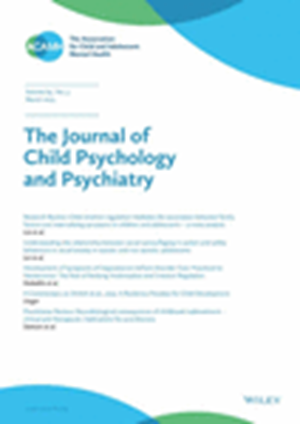学龄自闭症儿童的神经成像生物标志物:mri测量的边缘系统脂质含量。
IF 7
1区 医学
Q1 PSYCHIATRY
引用次数: 0
摘要
自闭症谱系障碍(ASD)是一种复杂的神经发育障碍。脑脂质的改变可能阐明ASD的神经生理机制,但证据仍然有限。本研究旨在评估mri测量的边缘脑区域脂质含量是否可以作为学龄ASD儿童神经生理变化的新生物标志物。方法本前瞻性研究纳入了98名学龄(7-16岁)ASD儿童和94名年龄和性别匹配的典型发育(TD)儿童,年龄窗口根据已确定的脑结构成熟里程碑选择。通过基于mri的质子密度脂肪分数(PDFF)定量脑边缘区脂质含量。分析组间差异、血脂相关性和临床量表相关性。体外验证和ASD小鼠的组织病理学证实了脂质定量的准确性和沉积。受试者工作特征(ROC)分析评估诊断效用。结果ASD患儿双侧梭状回(FUS) mri测量脂质含量显著升高(pfdr < 0.01),脂质含量与总胆固醇呈正相关(左半球:r =。38, p < 0.01;右半球r =。46, p < 0.01)。用硫酸铁铵染色对BTBR小鼠脑切片进行组织病理学检查,发现明显的胆固醇沉积。此外,双侧尾侧前扣带皮层(cACC)的脂质含量降低(左半球:pfdr <。01,右半球:pfdr < .01),右侧cACC脂质含量与社交障碍呈负相关(r = -)。32, pfdr = .04)。ROC分析结果显示,双侧FUS和cACC脂质含量的多模式整合产生了最高的AUC (0.89, 95% CI: 0.84-0.94)。结论FUS和cACC的改变强调了它们在ASD神经病理学中的作用。这些发现表明,mri测量的大脑边缘系统特定区域的脂质水平可以作为ASD学龄儿童神经生理变化的生物标志物。本文章由计算机程序翻译,如有差异,请以英文原文为准。
Neuroimaging biomarkers in school-aged children with autism: MRI-measured lipid content in the limbic system.
BACKGROUND
Autism spectrum disorder (ASD) is a complex neurodevelopmental disorder. Alterations in brain lipids may elucidate ASD's neurophysiological mechanisms, but evidence remains limited. This study aims to assess whether the MRI-measured lipid content in limbic brain regions could serve as novel biomarkers for neurophysiological changes in school-aged children with ASD.
METHODS
This prospective study included 98 school-aged (7-16 years) children with ASD and 94 age- and gender-matched typically developing (TD) children, an age window selected based on established milestones of structural brain maturation. Lipid content in limbic regions was quantified via MRI-based proton density fat fraction (PDFF). Between-group differences, blood lipid correlations, and clinical scale associations were analyzed. In vitro validation and histopathology in ASD mice confirmed lipid quantification accuracy and deposits. Receiver operating characteristic (ROC) analyses evaluated diagnostic utility.
RESULTS
Children with ASD exhibited significantly elevated MRI-measured lipid content in the bilateral fusiform gyrus (FUS) (pfdr < .01), with positive correlations observed between lipid content and total cholesterol (left hemisphere: r = .38, p < .01; right hemisphere r = .46, p < .01). Histopathological examination of BTBR mice brain sections stained with ammonium ferric sulfate revealed significant cholesterol deposits. Additionally, reduced lipid content in the bilateral caudal anterior cingulate cortex (cACC) (left hemisphere: pfdr < .01, right hemisphere: pfdr < .01) was found in children with ASD, and the lipid content of the right cACC was negatively correlated with impairments in social communication (r = -.32, pfdr = .04). Results of ROC analyses demonstrated that multimodal integration of bilateral FUS and cACC lipid contents yielded the highest AUC (0.89, 95% CI: 0.84-0.94).
CONCLUSIONS
Alterations in the FUS and cACC underscore their roles in ASD neuropathology. These findings suggest that MRI-measured lipid levels of specific regions from the brain limbic system could serve as a biomarker for neurophysiological changes in school-aged children with ASD.
求助全文
通过发布文献求助,成功后即可免费获取论文全文。
去求助
来源期刊
CiteScore
13.80
自引率
5.30%
发文量
169
审稿时长
1 months
期刊介绍:
The Journal of Child Psychology and Psychiatry (JCPP) is a highly regarded international publication that focuses on the fields of child and adolescent psychology and psychiatry. It is recognized for publishing top-tier, clinically relevant research across various disciplines related to these areas. JCPP has a broad global readership and covers a diverse range of topics, including:
Epidemiology: Studies on the prevalence and distribution of mental health issues in children and adolescents.
Diagnosis: Research on the identification and classification of childhood disorders.
Treatments: Psychotherapeutic and psychopharmacological interventions for child and adolescent mental health.
Behavior and Cognition: Studies on the behavioral and cognitive aspects of childhood disorders.
Neuroscience and Neurobiology: Research on the neural and biological underpinnings of child mental health.
Genetics: Genetic factors contributing to the development of childhood disorders.
JCPP serves as a platform for integrating empirical research, clinical studies, and high-quality reviews from diverse perspectives, theoretical viewpoints, and disciplines. This interdisciplinary approach is a key feature of the journal, as it fosters a comprehensive understanding of child and adolescent mental health.
The Journal of Child Psychology and Psychiatry is published 12 times a year and is affiliated with the Association for Child and Adolescent Mental Health (ACAMH), which supports the journal's mission to advance knowledge and practice in the field of child and adolescent mental health.

 求助内容:
求助内容: 应助结果提醒方式:
应助结果提醒方式:


